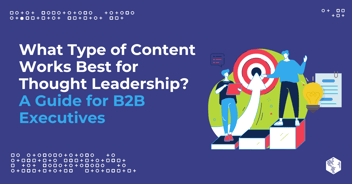Table Of Contents
Thought leadership is one of the most powerful ways for your B2B company to build credibility, engage with your audience, influence potential customers, and stand out in a crowded marketplace—when it’s done right. However, truly impactful thought leadership doesn’t start with an article, a video, a post, or a webinar. It starts with a strong, well-defined idea.
Without a compelling central idea, even the most well-executed content will struggle to make a lasting impact.
Truly effective B2B thought leadership content serves a bigger, more cohesive narrative. When you center your strategy around a strong idea, you create a lasting impact.
Why Strong Ideas Drive Thought Leadership Success
Thought leadership requires contributing new perspectives, insights, and knowledge to your industry. You can’t just regurgitate commonly known information; to be a successful thought leader, you have to offer something fresh, innovative, and thought-provoking.
Many wannabe thought leaders fall into the trap of creating isolated pieces of content—a blog post one day, a webinar the next, and a few scattered social media updates in the meantime. But while this approach can generate short-term engagement, it often lacks long-term impact. A well-defined central idea, however, allows you to create a cohesive narrative that reinforces your expertise and strengthens your brand’s position in the market.
-May-15-2025-08-52-02-9498-PM.png?width=1920&height=1005&name=HubSpot%20Content%20Hub%20for%20Marketers%20(2)-May-15-2025-08-52-02-9498-PM.png)
A strong idea should serve as the foundation for all your thought leadership efforts, guiding your content strategy and ensuring consistency across platforms. It helps you:
- Stand out by offering something unique.
- Create a consistent message across all content formats.
- Reinforce your expertise and build trust with your audience.
- Drive meaningful discussions that position your brand as a leader.
According to the Content Marketing Institute, 52% of B2B marketers plan to increase investment in thought leadership content in 2025. That means competition for attention is growing. A compelling, well-developed idea is what makes your content stand out.
-May-15-2025-08-52-05-6790-PM.png?width=1920&height=1005&name=HubSpot%20Content%20Hub%20for%20Marketers%20(3)-May-15-2025-08-52-05-6790-PM.png)
What Does an “Idea” Look Like in B2B Thought Leadership?
A thought leadership idea is a unique perspective or argument that drives meaningful discussions in your industry.
It’s more than a topic or a keyword. In fact, a strong thought leadership idea should help your content SOAR:
- Sustainable: It is broad enough to fuel multiple pieces of content but focused enough to remain coherent.
- Original: It challenges conventional wisdom or presents a new way of thinking.
- Actionable: It offers insights that professionals can apply to their work.
- Relevant: It directly addresses the needs, pain points, or aspirations of your target audience.
For example, instead of writing a generic article about “The Future of B2B Marketing,” a stronger thought leadership idea might be, “Why B2B Brands Must Prioritize Human-Centered Marketing in an AI-Driven World.” This idea is more specific, offers a clear point of view, and invites discussion.
-May-15-2025-08-52-05-6296-PM.png?width=1920&height=1005&name=HubSpot%20Content%20Hub%20for%20Marketers%20(4)-May-15-2025-08-52-05-6296-PM.png)
How to Develop Your Own Thought Leadership Ideas: 6 Steps to Follow
If you want you or your brand to be recognized as a thought leader, you need to consistently generate and refine strong ideas. Follow these steps to develop your own B2B thought leadership strategy.
1. Start with What Makes You & Your Company Unique
Your company’s unique value proposition (UVP) is the foundation of your thought leadership. What makes your business different? What unique insights can you offer that no one else can? Identifying your UVP will help you create content that aligns with your brand’s strengths and expertise.
2. Brainstorm Themes & Big Ideas in Your Industry
Once you have clarity on your UVP, start brainstorming overarching themes and ideas. Ask yourself:
- What challenges is our industry facing?
- What trends are shaping our market?
- What expertise do we have that others don’t?
These themes should be broad enough to allow for multiple content pieces but specific enough to be distinct to your brand.
3. Get Feedback on Your Idea
Not every idea will be a winner. Before committing to a theme, test it with small-scale experiments—write a blog post, discuss it on LinkedIn, or present it in a webinar. Gauge how your audience reacts. If the idea gains traction and sparks conversation, it’s worth developing further.
4. Commit to Your Central Idea
Once you’ve identified a strong idea, build a content strategy around it. Instead of creating disjointed pieces of content, ensure everything ties back to your central idea. This approach reinforces your message and keeps your brand top-of-mind.
5. Develop a Multichannel Distribution Strategy
Your thought leadership idea should be communicated across multiple channels to reach different audience segments. Consider many different types of content formats and distribution strategies:
- Long-form content: Whitepapers, research reports, in-depth blog posts
- Short-form content: Social media posts, email newsletters, infographics
- Interactive content: Webinars, live Q&A sessions, LinkedIn polls
- Video and audio content: Podcasts, expert interviews, video explainers
- Speaking engagements: Conferences, panel discussions, industry roundtables
By using different formats and distributing across many channels, you can maximize the reach of your idea and ensure that it resonates with various audience preferences while also keeping it connected to your core idea.
6. Measure & Adapt
Monitor the performance of your thought leadership content. Are people engaging with it? Is it driving meaningful conversations? Use analytics to refine your approach, and make adjustments as needed to ensure your ideas remain relevant and impactful.
Putting It All Together: A B2B Thought Leadership Example
Let’s see how this process works in a real-world B2B scenario. Imagine a manufacturing company specializing in automation that wants to establish itself as a thought leader. How would marketers at this manufacturing company come up with strong thought leadership ideas and content?
Step 1: Identifying a Central Idea
Instead of writing general content on automation, the company identifies a central thought leadership theme: “The Future of Smart Factories: Why AI-Driven Manufacturing is the Key to Industry 4.0 Success.”
Step 2: Developing Content Around the Idea
Rather than creating disconnected content, the company structures all its efforts around this central theme. Here’s what that looks like:
- Blog post series: Articles on how AI is improving production efficiency, reducing waste, and optimizing supply chains
- Webinar and video content: Expert discussions featuring industry leaders talking about real-world AI applications in manufacturing
- White papers and case studies: Detailed industry reports showcasing data-driven insights on smart factories and AI adoption
- LinkedIn and other social media: Thought-provoking posts and infographics that break down key findings and encourage industry discussions
- Podcasts and interviews: Conversations with experts discussing how AI is reshaping the manufacturing industry and what companies need to do to stay ahead
Each content format, type, and style reaches different audiences but still draws on a common theme, emphasizing it so it becomes synonymous with the company name.
Step 3: Distributing & Reinforcing the Idea
Instead of treating each content asset as a separate initiative, the company ensures all marketing efforts tie back to the same overarching theme. For example:
- A LinkedIn post promoting the webinar links back to the blog series.
- A case study showcasing AI implementation references the insights from the white paper.
- A podcast featuring the company’s executives discussing the future of AI in manufacturing reinforces the brand’s authority on the topic.
- A series of short, engaging video clips on social media highlight key takeaways from the webinar and drive audiences toward in-depth content.
Step 4: Partnering with Industry Leaders
To expand reach, the company collaborates with industry influencers, trade publications, and business partners to amplify the message. Guest articles, joint webinars, and co-branded research help establish credibility and bring new audiences into the conversation.
Step 5: Measuring & Optimizing
The company tracks key engagement metrics—such as time spent on content, social shares, and lead generation—to determine which aspects of the campaign resonate most. This data informs future content creation and helps refine the message.
Additionally, gathering direct feedback from industry peers and customers allows the company to adjust its messaging and stay relevant in the evolving landscape.
Conclusion: Focus on the Idea, Not Just the Content
The most successful B2B brands aren’t just content creators. They’re idea-driven leaders.
By developing and committing to a compelling thought leadership idea, you can differentiate your brand, build credibility, and drive meaningful conversations in your industry. Instead of treating content as a series of one-off pieces, think of it as a vessel for distributing a powerful, central idea. In doing so, you’ll position your brand as a true leader in your field and create content that stands the test of time.
At OneIMS, we’re in the business of helping B2B professionals become thought leaders, build their brand, and reach new heights. Schedule a consultation with us today to learn how we can help you grow your company and get the results you’re looking for.





